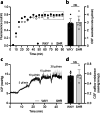Spontaneously hypertensive rats can become hydrocephalic despite undisturbed secretion and drainage of cerebrospinal fluid
- PMID: 37403103
- PMCID: PMC10318838
- DOI: 10.1186/s12987-023-00448-x
Spontaneously hypertensive rats can become hydrocephalic despite undisturbed secretion and drainage of cerebrospinal fluid
Abstract
Background: Hydrocephalus constitutes a complex neurological condition of heterogeneous origin characterized by excessive cerebrospinal fluid (CSF) accumulation within the brain ventricles. The condition may dangerously elevate the intracranial pressure (ICP) and cause severe neurological impairments. Pharmacotherapies are currently unavailable and treatment options remain limited to surgical CSF diversion, which follows from our incomplete understanding of the hydrocephalus pathogenesis. Here, we aimed to elucidate the molecular mechanisms underlying development of hydrocephalus in spontaneously hypertensive rats (SHRs), which develop non-obstructive hydrocephalus without the need for surgical induction.
Methods: Magnetic resonance imaging was employed to delineate brain and CSF volumes in SHRs and control Wistar-Kyoto (WKY) rats. Brain water content was determined from wet and dry brain weights. CSF dynamics related to hydrocephalus formation in SHRs were explored in vivo by quantifying CSF production rates, ICP, and CSF outflow resistance. Associated choroid plexus alterations were elucidated with immunofluorescence, western blotting, and through use of an ex vivo radio-isotope flux assay.
Results: SHRs displayed brain water accumulation and enlarged lateral ventricles, in part compensated for by a smaller brain volume. The SHR choroid plexus demonstrated increased phosphorylation of the Na+/K+/2Cl- cotransporter NKCC1, a key contributor to choroid plexus CSF secretion. However, neither CSF production rate, ICP, nor CSF outflow resistance appeared elevated in SHRs when compared to WKY rats.
Conclusion: Hydrocephalus development in SHRs does not associate with elevated ICP and does not require increased CSF secretion or inefficient CSF drainage. SHR hydrocephalus thus represents a type of hydrocephalus that is not life threatening and that occurs by unknown disturbances to the CSF dynamics.
Keywords: Cerebrospinal fluid; Choroid plexus; Hydrocephalus; Intracranial pressure; Outflow resistance; Spontaneously hypertensive rat; Ventriculomegaly.
© 2023. The Author(s).
Conflict of interest statement
The authors declare no competing interests.
Figures




Similar articles
-
The Na+,K+,2Cl- Cotransporter, Not Aquaporin 1, Sustains Cerebrospinal Fluid Secretion While Controlling Brain K+ Homeostasis.Adv Sci (Weinh). 2025 Feb;12(6):e2409120. doi: 10.1002/advs.202409120. Epub 2024 Dec 18. Adv Sci (Weinh). 2025. PMID: 39692709 Free PMC article.
-
Elevated CSF inflammatory markers in patients with idiopathic normal pressure hydrocephalus do not promote NKCC1 hyperactivity in rat choroid plexus.Fluids Barriers CNS. 2021 Dec 4;18(1):54. doi: 10.1186/s12987-021-00289-6. Fluids Barriers CNS. 2021. PMID: 34863228 Free PMC article.
-
Posthemorrhagic hydrocephalus associates with elevated inflammation and CSF hypersecretion via activation of choroidal transporters.Fluids Barriers CNS. 2022 Aug 10;19(1):62. doi: 10.1186/s12987-022-00360-w. Fluids Barriers CNS. 2022. PMID: 35948938 Free PMC article.
-
Cerebrospinal fluid hypersecretion in pediatric hydrocephalus.Neurosurg Focus. 2016 Nov;41(5):E10. doi: 10.3171/2016.8.FOCUS16278. Neurosurg Focus. 2016. PMID: 27798982 Review.
-
Cerebrospinal fluid dynamics and intracranial pressure elevation in neurological diseases.Fluids Barriers CNS. 2019 Apr 10;16(1):9. doi: 10.1186/s12987-019-0129-6. Fluids Barriers CNS. 2019. PMID: 30967147 Free PMC article. Review.
Cited by
-
Hypertension: Causes and Consequences of Circadian Rhythms in Blood Pressure.Circ Res. 2024 Mar 15;134(6):810-832. doi: 10.1161/CIRCRESAHA.124.323515. Epub 2024 Mar 14. Circ Res. 2024. PMID: 38484034 Free PMC article. Review.
-
The Na+,K+,2Cl- Cotransporter, Not Aquaporin 1, Sustains Cerebrospinal Fluid Secretion While Controlling Brain K+ Homeostasis.Adv Sci (Weinh). 2025 Feb;12(6):e2409120. doi: 10.1002/advs.202409120. Epub 2024 Dec 18. Adv Sci (Weinh). 2025. PMID: 39692709 Free PMC article.
-
Alterations in Striatal Architecture and Biochemical Markers' Levels During Postnatal Development in the Rat Model of an Attention Deficit/Hyperactivity Disorder (ADHD).Int J Mol Sci. 2024 Dec 20;25(24):13652. doi: 10.3390/ijms252413652. Int J Mol Sci. 2024. PMID: 39769412 Free PMC article.
-
Familial vs sporadic normal pressure hydrocephalus: a comparative study.J Neurol. 2025 Feb 25;272(3):229. doi: 10.1007/s00415-025-12970-z. J Neurol. 2025. PMID: 39998670
-
The Cerebrospinal Fluid Secretion Rate Increases in Awake and Freely Moving Rats but Differs With Experimental Methodology.Adv Sci (Weinh). 2025 May;12(17):e2412469. doi: 10.1002/advs.202412469. Epub 2025 Mar 12. Adv Sci (Weinh). 2025. PMID: 40071749 Free PMC article.
References
-
- Williams MA, Nagel SJ, Luciano MG, Relkin N, Zwimpfer TJ, Katzen H, et al. The clinical spectrum of hydrocephalus in adults: report of the first 517 patients of the adult Hydrocephalus Clinical Research Network registry. J Neurosurg. 2019;132:1773–84. - PubMed
-
- di Curzio DL. Animal models of Hydrocephalus. Open J Mod Neurosurg. 2018;08:57–71.
MeSH terms
Substances
LinkOut - more resources
Full Text Sources
Medical

